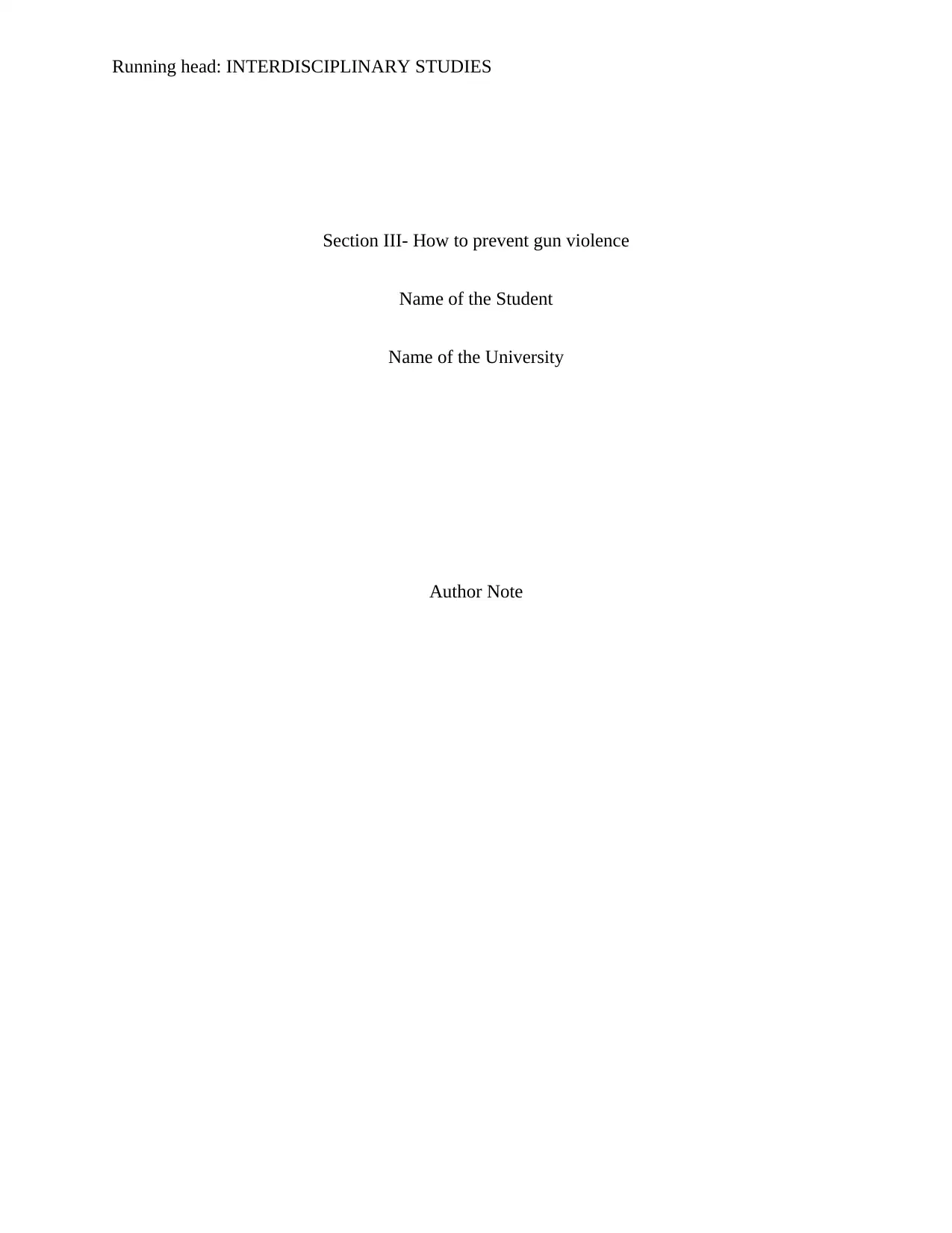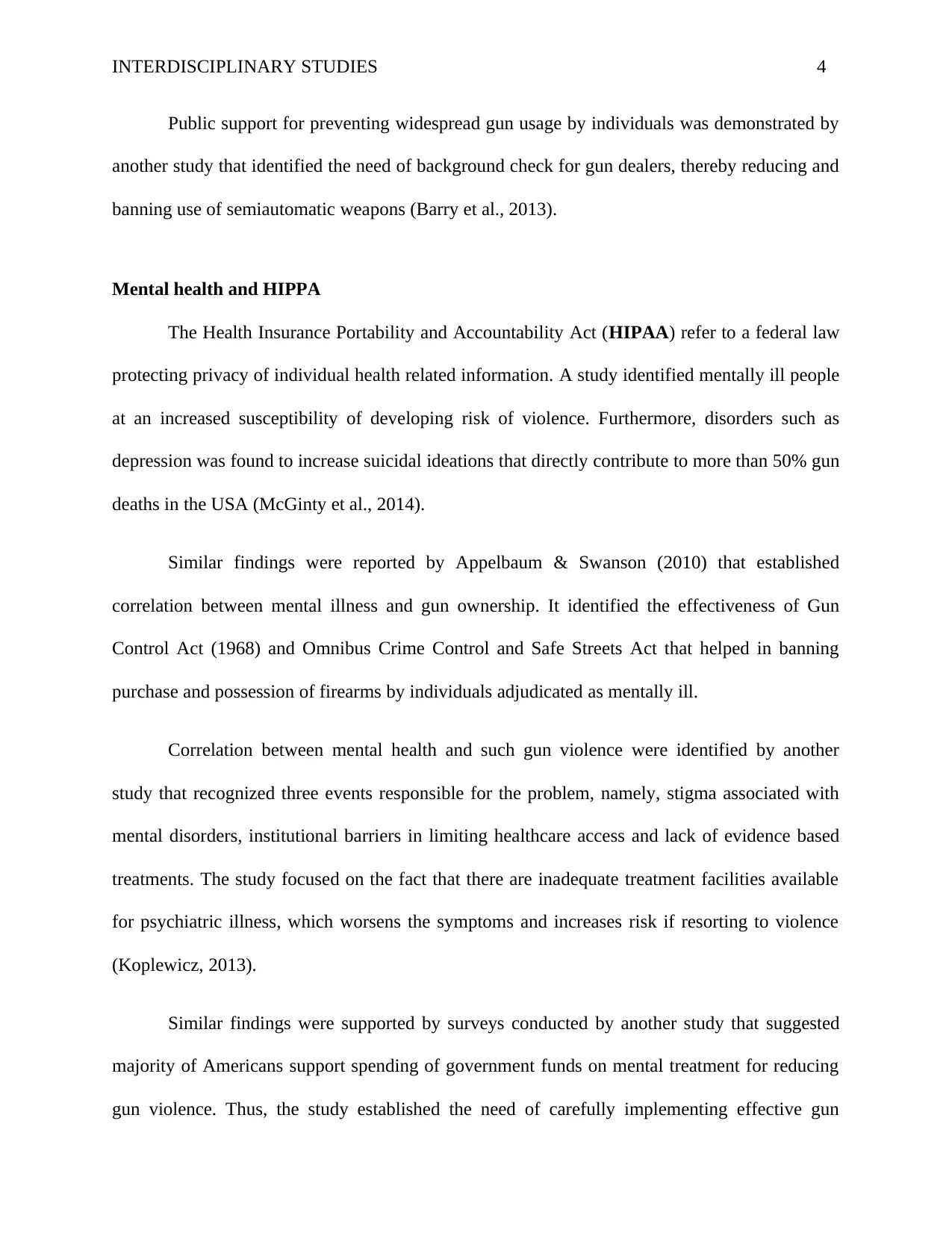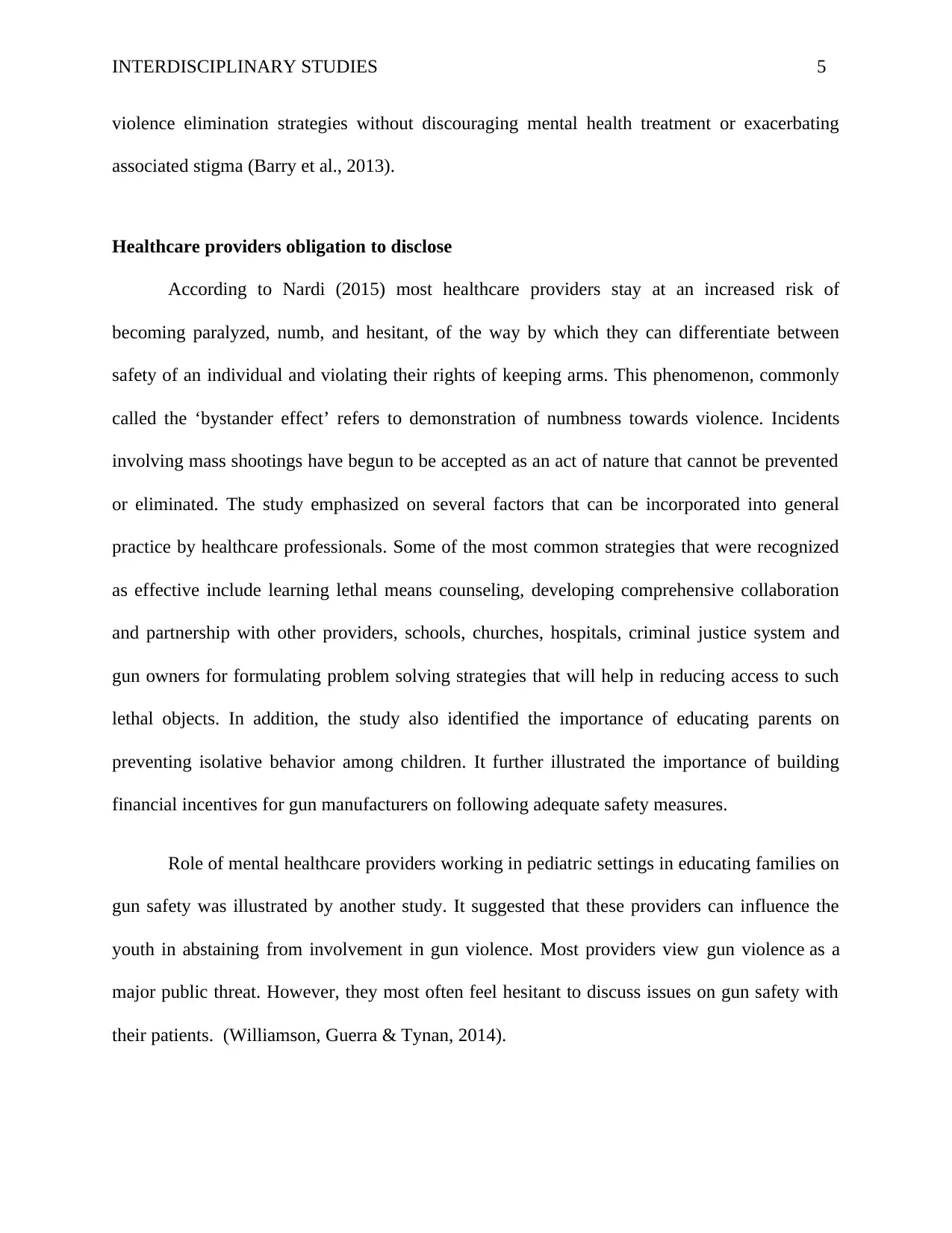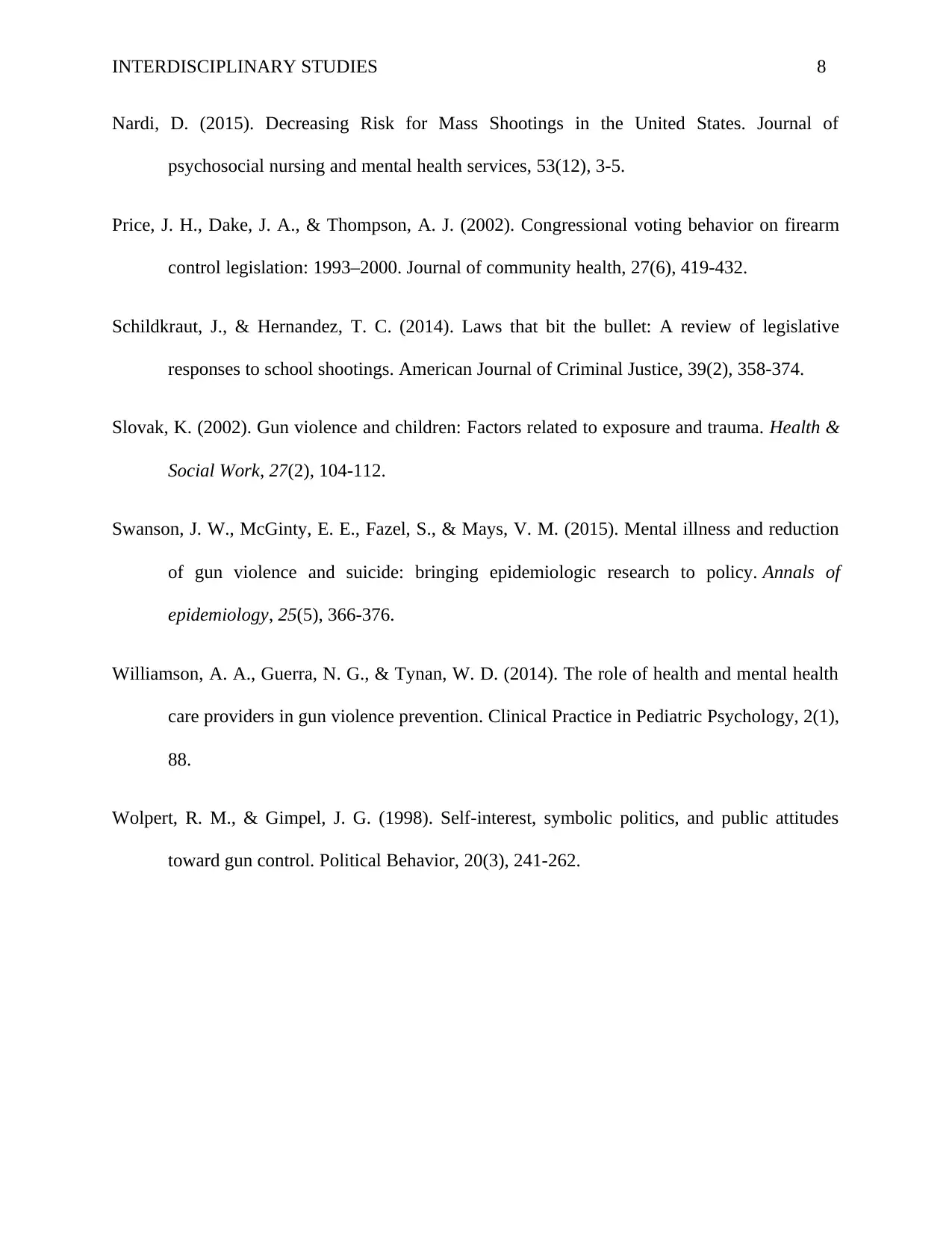Preventing Gun Violence: Strategies and Recommendations
VerifiedAdded on 2023/06/15
|9
|2158
|190
AI Summary
This article discusses effective methods of preventing gun violence, including background checks, mental health treatment, and healthcare providers' obligations to disclose. It also examines the correlation between gun control legislation and political donations.
Contribute Materials
Your contribution can guide someone’s learning journey. Share your
documents today.

Running head: INTERDISCIPLINARY STUDIES
Section III- How to prevent gun violence
Name of the Student
Name of the University
Author Note
Section III- How to prevent gun violence
Name of the Student
Name of the University
Author Note
Secure Best Marks with AI Grader
Need help grading? Try our AI Grader for instant feedback on your assignments.

INTERDISCIPLINARY STUDIES 1
Table of Contents
Background check...........................................................................................................................3
Mental health and HIPPA................................................................................................................4
Healthcare providers obligation to disclose.....................................................................................5
Reporting about high risk violent patient in the database................................................................6
References........................................................................................................................................7
Table of Contents
Background check...........................................................................................................................3
Mental health and HIPPA................................................................................................................4
Healthcare providers obligation to disclose.....................................................................................5
Reporting about high risk violent patient in the database................................................................6
References........................................................................................................................................7

INTERDISCIPLINARY STUDIES 2
Gun related violence refers to violence that is committed by using a firearm such as, a
gun. Gun violence is not considered as a criminal offense in certain instances. Criminal violence
cases are registered that include homicide, assault using some deadly weapon, and attempted
suicide, depending on jurisdiction of the concerned state (Hemenway & Miller, 2013). Non-
criminal violence often includes unintentional or accidental injury, thereby leading to death
(except in specific cases of criminal negligence). This assignment will focus on the ways that
have been identified by relevant literature, as effective methods of preventing gun violence.
Price, Dake and Thompson (2002) stated that morbidity and mortality due to firearms
place a huge burden on the society and the healthcare enterprises that operate within it. It
illustrated the findings of recent research that demonstrated effectiveness of strong public
support and strategies for regulating use of firearms. Furthermore, the study emphasized on the
fact that approximately 200 million firearm are owned by 25% adults in the United States. The
primary objective of the study was based on evaluating factors that are associated with voting
behavior of the Congress on legislations related to firearm control. The results indicated that
members of the US Congress received huge donations from groups that were related with firearm
legislations. The results therefore established a strong correlation between positions of a
Congressional member on firearm legislation with the amount of money donated. Furthermore, it
stated that people receiving gun fund rights were at an increased likelihood of voting pro gun
rights. Thus, reducing the donation amount will help in lowering opinion that favors gun rights,
thereby creating a significant impact on gun violence rates.
Wolpert and Gimpel (1998) conducted a study that examined attitudes of the public
towards gun control with the aim of determining distinctive policy preferences exhibited by gun
owners. Demographic, symbolic and self-interest factors were thought to be instrumental in
Gun related violence refers to violence that is committed by using a firearm such as, a
gun. Gun violence is not considered as a criminal offense in certain instances. Criminal violence
cases are registered that include homicide, assault using some deadly weapon, and attempted
suicide, depending on jurisdiction of the concerned state (Hemenway & Miller, 2013). Non-
criminal violence often includes unintentional or accidental injury, thereby leading to death
(except in specific cases of criminal negligence). This assignment will focus on the ways that
have been identified by relevant literature, as effective methods of preventing gun violence.
Price, Dake and Thompson (2002) stated that morbidity and mortality due to firearms
place a huge burden on the society and the healthcare enterprises that operate within it. It
illustrated the findings of recent research that demonstrated effectiveness of strong public
support and strategies for regulating use of firearms. Furthermore, the study emphasized on the
fact that approximately 200 million firearm are owned by 25% adults in the United States. The
primary objective of the study was based on evaluating factors that are associated with voting
behavior of the Congress on legislations related to firearm control. The results indicated that
members of the US Congress received huge donations from groups that were related with firearm
legislations. The results therefore established a strong correlation between positions of a
Congressional member on firearm legislation with the amount of money donated. Furthermore, it
stated that people receiving gun fund rights were at an increased likelihood of voting pro gun
rights. Thus, reducing the donation amount will help in lowering opinion that favors gun rights,
thereby creating a significant impact on gun violence rates.
Wolpert and Gimpel (1998) conducted a study that examined attitudes of the public
towards gun control with the aim of determining distinctive policy preferences exhibited by gun
owners. Demographic, symbolic and self-interest factors were thought to be instrumental in

INTERDISCIPLINARY STUDIES 3
attainment of individual goals. Crime victims and gun owners were identified as major
individuals having a personal stake in this issue. Furthermore, the research also stated that people
having victimized by crime are most susceptible to gaining benefits from gun control
legislations. It emphasized on the fact that gun owners most often display their personal stake in
restrictions on gun usage. On examining the different contributing factors, the results indicated
failure of self-interest in influencing policy attitudes. Furthermore, it identified gun control as
policies that make it easier for gun owners to place the responsibility of their safety and
wellbeing on the government. Moreover, the results also suggested that failure of gun control
legislations to polarize public on the basis of ideological grounds makes self-control effective.
Thus, self-control can work effectively in reducing gun violence.
Background check
Appelbaum and Swanson (2010) conducted a study that provided evidence for
implementation of stringent restrictions were reinforced on use of firearms with implementation
of the National Instant Criminal Background Check System (NICS). Furthermore, this study also
recognized initiatives taken by individual states in the form of databases that resulted in
implementation of restrictions on access of firearms.
Goss (2015) documented essential exceptions to conventional wisdom that focus on the
fact that most politicians fail to demonstrate behavior related to tightening gun laws. It
emphasized on the role of background check systems that licensed gun sellers to use firearms
without any difficulty, while transferring them to private individuals. It illustrated the role of
National Instant Criminal Background Check System (NICS) Improvement Amendments Act
(2007) in bringing about reforms in gun rights.
attainment of individual goals. Crime victims and gun owners were identified as major
individuals having a personal stake in this issue. Furthermore, the research also stated that people
having victimized by crime are most susceptible to gaining benefits from gun control
legislations. It emphasized on the fact that gun owners most often display their personal stake in
restrictions on gun usage. On examining the different contributing factors, the results indicated
failure of self-interest in influencing policy attitudes. Furthermore, it identified gun control as
policies that make it easier for gun owners to place the responsibility of their safety and
wellbeing on the government. Moreover, the results also suggested that failure of gun control
legislations to polarize public on the basis of ideological grounds makes self-control effective.
Thus, self-control can work effectively in reducing gun violence.
Background check
Appelbaum and Swanson (2010) conducted a study that provided evidence for
implementation of stringent restrictions were reinforced on use of firearms with implementation
of the National Instant Criminal Background Check System (NICS). Furthermore, this study also
recognized initiatives taken by individual states in the form of databases that resulted in
implementation of restrictions on access of firearms.
Goss (2015) documented essential exceptions to conventional wisdom that focus on the
fact that most politicians fail to demonstrate behavior related to tightening gun laws. It
emphasized on the role of background check systems that licensed gun sellers to use firearms
without any difficulty, while transferring them to private individuals. It illustrated the role of
National Instant Criminal Background Check System (NICS) Improvement Amendments Act
(2007) in bringing about reforms in gun rights.
Secure Best Marks with AI Grader
Need help grading? Try our AI Grader for instant feedback on your assignments.

INTERDISCIPLINARY STUDIES 4
Public support for preventing widespread gun usage by individuals was demonstrated by
another study that identified the need of background check for gun dealers, thereby reducing and
banning use of semiautomatic weapons (Barry et al., 2013).
Mental health and HIPPA
The Health Insurance Portability and Accountability Act (HIPAA) refer to a federal law
protecting privacy of individual health related information. A study identified mentally ill people
at an increased susceptibility of developing risk of violence. Furthermore, disorders such as
depression was found to increase suicidal ideations that directly contribute to more than 50% gun
deaths in the USA (McGinty et al., 2014).
Similar findings were reported by Appelbaum & Swanson (2010) that established
correlation between mental illness and gun ownership. It identified the effectiveness of Gun
Control Act (1968) and Omnibus Crime Control and Safe Streets Act that helped in banning
purchase and possession of firearms by individuals adjudicated as mentally ill.
Correlation between mental health and such gun violence were identified by another
study that recognized three events responsible for the problem, namely, stigma associated with
mental disorders, institutional barriers in limiting healthcare access and lack of evidence based
treatments. The study focused on the fact that there are inadequate treatment facilities available
for psychiatric illness, which worsens the symptoms and increases risk if resorting to violence
(Koplewicz, 2013).
Similar findings were supported by surveys conducted by another study that suggested
majority of Americans support spending of government funds on mental treatment for reducing
gun violence. Thus, the study established the need of carefully implementing effective gun
Public support for preventing widespread gun usage by individuals was demonstrated by
another study that identified the need of background check for gun dealers, thereby reducing and
banning use of semiautomatic weapons (Barry et al., 2013).
Mental health and HIPPA
The Health Insurance Portability and Accountability Act (HIPAA) refer to a federal law
protecting privacy of individual health related information. A study identified mentally ill people
at an increased susceptibility of developing risk of violence. Furthermore, disorders such as
depression was found to increase suicidal ideations that directly contribute to more than 50% gun
deaths in the USA (McGinty et al., 2014).
Similar findings were reported by Appelbaum & Swanson (2010) that established
correlation between mental illness and gun ownership. It identified the effectiveness of Gun
Control Act (1968) and Omnibus Crime Control and Safe Streets Act that helped in banning
purchase and possession of firearms by individuals adjudicated as mentally ill.
Correlation between mental health and such gun violence were identified by another
study that recognized three events responsible for the problem, namely, stigma associated with
mental disorders, institutional barriers in limiting healthcare access and lack of evidence based
treatments. The study focused on the fact that there are inadequate treatment facilities available
for psychiatric illness, which worsens the symptoms and increases risk if resorting to violence
(Koplewicz, 2013).
Similar findings were supported by surveys conducted by another study that suggested
majority of Americans support spending of government funds on mental treatment for reducing
gun violence. Thus, the study established the need of carefully implementing effective gun

INTERDISCIPLINARY STUDIES 5
violence elimination strategies without discouraging mental health treatment or exacerbating
associated stigma (Barry et al., 2013).
Healthcare providers obligation to disclose
According to Nardi (2015) most healthcare providers stay at an increased risk of
becoming paralyzed, numb, and hesitant, of the way by which they can differentiate between
safety of an individual and violating their rights of keeping arms. This phenomenon, commonly
called the ‘bystander effect’ refers to demonstration of numbness towards violence. Incidents
involving mass shootings have begun to be accepted as an act of nature that cannot be prevented
or eliminated. The study emphasized on several factors that can be incorporated into general
practice by healthcare professionals. Some of the most common strategies that were recognized
as effective include learning lethal means counseling, developing comprehensive collaboration
and partnership with other providers, schools, churches, hospitals, criminal justice system and
gun owners for formulating problem solving strategies that will help in reducing access to such
lethal objects. In addition, the study also identified the importance of educating parents on
preventing isolative behavior among children. It further illustrated the importance of building
financial incentives for gun manufacturers on following adequate safety measures.
Role of mental healthcare providers working in pediatric settings in educating families on
gun safety was illustrated by another study. It suggested that these providers can influence the
youth in abstaining from involvement in gun violence. Most providers view gun violence as a
major public threat. However, they most often feel hesitant to discuss issues on gun safety with
their patients. (Williamson, Guerra & Tynan, 2014).
violence elimination strategies without discouraging mental health treatment or exacerbating
associated stigma (Barry et al., 2013).
Healthcare providers obligation to disclose
According to Nardi (2015) most healthcare providers stay at an increased risk of
becoming paralyzed, numb, and hesitant, of the way by which they can differentiate between
safety of an individual and violating their rights of keeping arms. This phenomenon, commonly
called the ‘bystander effect’ refers to demonstration of numbness towards violence. Incidents
involving mass shootings have begun to be accepted as an act of nature that cannot be prevented
or eliminated. The study emphasized on several factors that can be incorporated into general
practice by healthcare professionals. Some of the most common strategies that were recognized
as effective include learning lethal means counseling, developing comprehensive collaboration
and partnership with other providers, schools, churches, hospitals, criminal justice system and
gun owners for formulating problem solving strategies that will help in reducing access to such
lethal objects. In addition, the study also identified the importance of educating parents on
preventing isolative behavior among children. It further illustrated the importance of building
financial incentives for gun manufacturers on following adequate safety measures.
Role of mental healthcare providers working in pediatric settings in educating families on
gun safety was illustrated by another study. It suggested that these providers can influence the
youth in abstaining from involvement in gun violence. Most providers view gun violence as a
major public threat. However, they most often feel hesitant to discuss issues on gun safety with
their patients. (Williamson, Guerra & Tynan, 2014).

INTERDISCIPLINARY STUDIES 6
Reporting about high risk violent patient in the database
Findings demonstrated by another study suggested an increase in stigmatizing attitude
towards mentally ill patients on use of lunatic database. These databases stigmatize people with
mental illness by dehumanize them, compromising their privacy, and threatening their
confidentiality (Gold, 2013).
Inclusion of mental health background check information in databases is debatable.
Several studies have been carried out that investigated effectiveness of such inclusion in treating
mental illness and preventing gun violence. The study suggested that such databases could be
detrimental to the mentally ill people by reinforcing stigmatizing attitudes towards them by
several members of the society. It also stated that such databases would hinder people from
seeking treatment (Kangas & Calvert, 2014).
Furthermore, findings from another study also suggested that although majority of people
suffering from serious mental illnesses have been found to be least violent, maintaining their
information in database and disclosing it for the purpose of reducing violence results in
development of a negative attitude, thereby stigmatizing the patients (Swanson et al., 2015).
To conclude, it can be suggested that parental supervision, treatment of violent patients
with social withdrawal symptoms, reducing firearm donations and imposing appropriate
legislations will be able to lower rates of gun violence.
Reporting about high risk violent patient in the database
Findings demonstrated by another study suggested an increase in stigmatizing attitude
towards mentally ill patients on use of lunatic database. These databases stigmatize people with
mental illness by dehumanize them, compromising their privacy, and threatening their
confidentiality (Gold, 2013).
Inclusion of mental health background check information in databases is debatable.
Several studies have been carried out that investigated effectiveness of such inclusion in treating
mental illness and preventing gun violence. The study suggested that such databases could be
detrimental to the mentally ill people by reinforcing stigmatizing attitudes towards them by
several members of the society. It also stated that such databases would hinder people from
seeking treatment (Kangas & Calvert, 2014).
Furthermore, findings from another study also suggested that although majority of people
suffering from serious mental illnesses have been found to be least violent, maintaining their
information in database and disclosing it for the purpose of reducing violence results in
development of a negative attitude, thereby stigmatizing the patients (Swanson et al., 2015).
To conclude, it can be suggested that parental supervision, treatment of violent patients
with social withdrawal symptoms, reducing firearm donations and imposing appropriate
legislations will be able to lower rates of gun violence.
Paraphrase This Document
Need a fresh take? Get an instant paraphrase of this document with our AI Paraphraser

INTERDISCIPLINARY STUDIES 7
References
Appelbaum, P. S., & Swanson, J. W. (2010). Law & psychiatry: gun laws and mental illness:
how sensible are the current restrictions?. Psychiatric Services, 61(7), 652-654.
Barry, C. L., McGinty, E. E., Vernick, J. S., & Webster, D. W. (2013). After Newtown—public
opinion on gun policy and mental illness. New England journal of medicine, 368(12),
1077-1081.
Gold, L. H. (2013). Gun violence: Psychiatry, risk assessment, and social policy. Journal of the
American Academy of Psychiatry and the Law, 41(3), 337-343.
Goss, K. A. (2015). Defying the odds on gun regulation: The passage of bipartisan mental health
laws across the States. American journal of orthopsychiatry, 85(3), 203.
Hemenway, D., & Miller, M. (2013). Public health approach to the prevention of gun violence. N
Engl J Med, 368(21), 2033-2035.
Kangas, J. L., & Calvert, J. D. (2014). Ethical issues in mental health background checks for
firearm ownership. Professional psychology: research and practice, 45(1), 76.
Koplewicz, H. S. (2013). Call to action. Journal of Child and Adolescent Psychopharmacology,
23(1), 2.
McGinty, E. E., Frattaroli, S., Appelbaum, P. S., Bonnie, R. J., Grilley, A., Horwitz, J., ... &
Webster, D. W. (2014). Using research evidence to reframe the policy debate around
mental illness and guns: process and recommendations. American journal of public
health, 104(11), e22-e26.
References
Appelbaum, P. S., & Swanson, J. W. (2010). Law & psychiatry: gun laws and mental illness:
how sensible are the current restrictions?. Psychiatric Services, 61(7), 652-654.
Barry, C. L., McGinty, E. E., Vernick, J. S., & Webster, D. W. (2013). After Newtown—public
opinion on gun policy and mental illness. New England journal of medicine, 368(12),
1077-1081.
Gold, L. H. (2013). Gun violence: Psychiatry, risk assessment, and social policy. Journal of the
American Academy of Psychiatry and the Law, 41(3), 337-343.
Goss, K. A. (2015). Defying the odds on gun regulation: The passage of bipartisan mental health
laws across the States. American journal of orthopsychiatry, 85(3), 203.
Hemenway, D., & Miller, M. (2013). Public health approach to the prevention of gun violence. N
Engl J Med, 368(21), 2033-2035.
Kangas, J. L., & Calvert, J. D. (2014). Ethical issues in mental health background checks for
firearm ownership. Professional psychology: research and practice, 45(1), 76.
Koplewicz, H. S. (2013). Call to action. Journal of Child and Adolescent Psychopharmacology,
23(1), 2.
McGinty, E. E., Frattaroli, S., Appelbaum, P. S., Bonnie, R. J., Grilley, A., Horwitz, J., ... &
Webster, D. W. (2014). Using research evidence to reframe the policy debate around
mental illness and guns: process and recommendations. American journal of public
health, 104(11), e22-e26.

INTERDISCIPLINARY STUDIES 8
Nardi, D. (2015). Decreasing Risk for Mass Shootings in the United States. Journal of
psychosocial nursing and mental health services, 53(12), 3-5.
Price, J. H., Dake, J. A., & Thompson, A. J. (2002). Congressional voting behavior on firearm
control legislation: 1993–2000. Journal of community health, 27(6), 419-432.
Schildkraut, J., & Hernandez, T. C. (2014). Laws that bit the bullet: A review of legislative
responses to school shootings. American Journal of Criminal Justice, 39(2), 358-374.
Slovak, K. (2002). Gun violence and children: Factors related to exposure and trauma. Health &
Social Work, 27(2), 104-112.
Swanson, J. W., McGinty, E. E., Fazel, S., & Mays, V. M. (2015). Mental illness and reduction
of gun violence and suicide: bringing epidemiologic research to policy. Annals of
epidemiology, 25(5), 366-376.
Williamson, A. A., Guerra, N. G., & Tynan, W. D. (2014). The role of health and mental health
care providers in gun violence prevention. Clinical Practice in Pediatric Psychology, 2(1),
88.
Wolpert, R. M., & Gimpel, J. G. (1998). Self-interest, symbolic politics, and public attitudes
toward gun control. Political Behavior, 20(3), 241-262.
Nardi, D. (2015). Decreasing Risk for Mass Shootings in the United States. Journal of
psychosocial nursing and mental health services, 53(12), 3-5.
Price, J. H., Dake, J. A., & Thompson, A. J. (2002). Congressional voting behavior on firearm
control legislation: 1993–2000. Journal of community health, 27(6), 419-432.
Schildkraut, J., & Hernandez, T. C. (2014). Laws that bit the bullet: A review of legislative
responses to school shootings. American Journal of Criminal Justice, 39(2), 358-374.
Slovak, K. (2002). Gun violence and children: Factors related to exposure and trauma. Health &
Social Work, 27(2), 104-112.
Swanson, J. W., McGinty, E. E., Fazel, S., & Mays, V. M. (2015). Mental illness and reduction
of gun violence and suicide: bringing epidemiologic research to policy. Annals of
epidemiology, 25(5), 366-376.
Williamson, A. A., Guerra, N. G., & Tynan, W. D. (2014). The role of health and mental health
care providers in gun violence prevention. Clinical Practice in Pediatric Psychology, 2(1),
88.
Wolpert, R. M., & Gimpel, J. G. (1998). Self-interest, symbolic politics, and public attitudes
toward gun control. Political Behavior, 20(3), 241-262.
1 out of 9
Your All-in-One AI-Powered Toolkit for Academic Success.
+13062052269
info@desklib.com
Available 24*7 on WhatsApp / Email
![[object Object]](/_next/static/media/star-bottom.7253800d.svg)
Unlock your academic potential
© 2024 | Zucol Services PVT LTD | All rights reserved.


